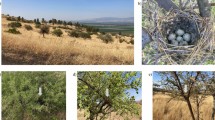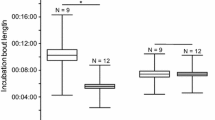Abstract
The selective pressures determining timing of reproduction and brood or litter size in animals remain to be clarified, despite much research. In several detailed studies of birds, selection for an early start of breeding has been demonstrated. Young born early in the season are often assumed to benefit from long experience, high dominance in flocks and/or early settlement in territories. For forest-breeding great tits (Parus major) in Sweden, predation by sparrowhawks (Accipiter nisus) was lower on fledglings hatched early than on those hatched late in the season. Hawk predation may therefore contribute to the higher success of early breeding great tits. Factors favouring early fledglings were (1) increasing food demands over the season in breeding hawks, and (2) hunting by hawks mainly in non-forest habitats when early tit fledglings left their nests. The proportion of fledglings taken was lower in broods of 2–6 than in broods of 7–12, indicating that predation favours small broods. Fledglings in large broods may be more vulnerable due to (1) a higher level of hunger and begging, and (2) higher provisioning rates by parents, which may reveal sites with fledglings to hawks. Territories of sparrowhawks were used as sample units in the statistical analysis, leading to strong inferences about predation at the landscape level.
Similar content being viewed by others
Author information
Authors and Affiliations
Additional information
Electronic Publication
Rights and permissions
About this article
Cite this article
Götmark, F. Predation by sparrowhawks favours early breeding and small broods in great tits. Oecologia 130, 25–32 (2002). https://doi.org/10.1007/s004420100769
Received:
Accepted:
Published:
Issue Date:
DOI: https://doi.org/10.1007/s004420100769




